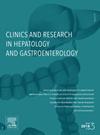镇痛药的使用和胰腺炎的风险:来自英国生物银行的结果。
IF 2.4
4区 医学
Q2 GASTROENTEROLOGY & HEPATOLOGY
Clinics and research in hepatology and gastroenterology
Pub Date : 2025-05-20
DOI:10.1016/j.clinre.2025.102616
引用次数: 0
摘要
背景:胰腺炎是一种炎症性胰腺疾病,可由多种病因引起,包括酒精、烟草和药物使用。尽管胰腺炎的发病与几种药物密切相关,但在基于人群的研究中,镇痛药的使用与胰腺炎风险之间的关系仍不明确。方法:这项前瞻性队列研究涉及来自英国生物银行的324,982名参与者。采用多变量调整的Cox比例风险模型来评估发生胰腺炎风险与镇痛药使用之间的纵向关联,镇痛药包括阿片类药物、非甾体抗炎药(NSAIDs)、扑热息痛、抗偏头痛制剂及其混合物。进行亚组分析和敏感性分析,以评估基线因素的潜在影响。结果:在13.70年的中位随访中,发现了2303例胰腺炎病例。在完全调整后的模型中,镇痛药的使用增加了胰腺炎(HR 1.13, 95% CI 1.04-1.23)、急性胰腺炎(AP) (HR 1.11, 95% CI 1.01-1.22)和慢性胰腺炎(CP) (HR 1.25, 95% CI 1.00-1.56)的风险(以上所有p结论:在这个基于人群的大型前瞻性队列中,镇痛药的使用,特别是阿片类药物和混合镇痛药,与胰腺炎风险增加有关。本文章由计算机程序翻译,如有差异,请以英文原文为准。
Analgesics use and risk of pancreatitis: Result from the UK Biobank
Background
Pancreatitis, an inflammatory pancreatic disorder, arises from various etiologies including alcohol, tobacco, and drug use. Although the initiation of pancreatitis has been strongly linked to several medications, the association between analgesic use and pancreatitis risk remains ambiguous in population-based studies.
Methods
This prospective cohort study involved 324,982 participants from the UK Biobank. Multivariable-adjusted Cox proportional hazards models were conducted to evaluate the longitudinal association between incident pancreatitis risk and analgesics use, encompassing opioids, non-steroidal anti-inflammatory drugs (NSAIDs), paracetamol, antimigraine preparations, and the mix. Subgroup and sensitivity analyses were conducted to assess the potential effects of baseline factors.
Results
Over a median follow-up of 13.70 years, 2303 cases of pancreatitis were identified. In the fully adjusted model, analgesics utilization increased the risk of pancreatitis (HR 1.13, 95 % CI 1.04–1.23), acute pancreatitis (AP) (HR 1.11, 95 % CI 1.01–1.22), and chronic pancreatitis (CP) (HR 1.25, 95 % CI 1.00–1.56) (All the above p < 0.05). Furthermore, participants who used opioids presented the highest risk of pancreatitis (HR 1.85, 95 % CI 1.49–2.31, p < 0.001), and the mixed group (HR 1.35, 95 % CI 1.21–1.51, p < 0.001) followed. Compared to the non-analgesics group, the risk of both AP and CP also increased in the opioids and the mixed group. Subgroup analysis indicated that the impact of analgesics utilization on the pancreatitis risk may vary with certain covariates, such as age, cholelithiasis, etc. (p-interaction <0.05).
Conclusion
In this large population-based prospective cohort, analgesics utilization, particularly opioids and mixed analgesics, was linked to an increased risk of pancreatitis.
求助全文
通过发布文献求助,成功后即可免费获取论文全文。
去求助
来源期刊

Clinics and research in hepatology and gastroenterology
GASTROENTEROLOGY & HEPATOLOGY-
CiteScore
4.30
自引率
3.70%
发文量
198
审稿时长
42 days
期刊介绍:
Clinics and Research in Hepatology and Gastroenterology publishes high-quality original research papers in the field of hepatology and gastroenterology. The editors put the accent on rapid communication of new research and clinical developments and so called "hot topic" issues. Following a clear Editorial line, besides original articles and case reports, each issue features editorials, commentaries and reviews. The journal encourages research and discussion between all those involved in the specialty on an international level. All articles are peer reviewed by international experts, the articles in press are online and indexed in the international databases (Current Contents, Pubmed, Scopus, Science Direct).
Clinics and Research in Hepatology and Gastroenterology is a subscription journal (with optional open access), which allows you to publish your research without any cost to you (unless you proactively chose the open access option). Your article will be available to all researchers around the globe whose institution has a subscription to the journal.
 求助内容:
求助内容: 应助结果提醒方式:
应助结果提醒方式:


